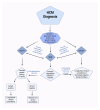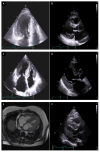Role of Genetics in Diagnosis and Management of Hypertrophic Cardiomyopathy: A Glimpse into the Future
- PMID: 38540296
- PMCID: PMC10968563
- DOI: 10.3390/biomedicines12030682
Role of Genetics in Diagnosis and Management of Hypertrophic Cardiomyopathy: A Glimpse into the Future
Abstract
Hypertrophic cardiomyopathy (HCM) is the most common inherited cardiomyopathy. It follows an autosomal dominant inheritance pattern in most cases, with incomplete penetrance and heterogeneity. It is familial in 60% of cases and most of these are caused by pathogenic variants in the core sarcomeric genes (MYH7, MYBPC3, TNNT2, TNNI3, MYL2, MYL3, TPM1, ACTC1). Genetic testing using targeted disease-specific panels that utilize next-generation sequencing (NGS) and include sarcomeric genes with the strongest evidence of association and syndrome-associated genes is highly recommended for every HCM patient to confirm the diagnosis, identify the molecular etiology, and guide screening and management. The yield of genetic testing for a disease-causing variant is 30% in sporadic cases and up to 60% in familial cases and in younger patients with typical asymmetrical septal hypertrophy. Genetic testing remains challenging in the interpretation of results and classification of variants. Therefore, in 2015 the American College of Medical Genetics and Genomics (ACMG) established guidelines to classify and interpret the variants with an emphasis on the necessity of periodic reassessment of variant classification as genetic knowledge rapidly expands. The current guidelines recommend focused cascade genetic testing regardless of age in phenotype-negative first-degree relatives if a variant with decisive evidence of pathogenicity has been identified in the proband. Genetic test results in family members guide longitudinal clinical surveillance. At present, there is emerging evidence for genetic test application in risk stratification and management but its implementation into clinical practice needs further study. Promising fields such as gene therapy and implementation of artificial intelligence in the diagnosis of HCM are emerging and paving the way for more effective screening and management, but many challenges and obstacles need to be overcome before establishing the practical implications of these new methods.
Keywords: cascade testing; gene therapy; hypertrophic cardiomyopathy; longitudinal surveillance; next-generation sequencing; phenocopies; sarcomeric genes; whole exome sequencing.
Conflict of interest statement
The authors declare no conflict of interest.
Figures



References
Publication types
LinkOut - more resources
Full Text Sources
Research Materials
Miscellaneous

